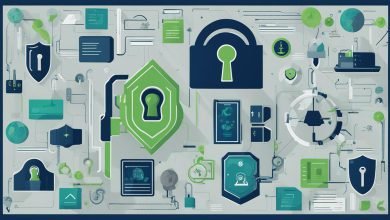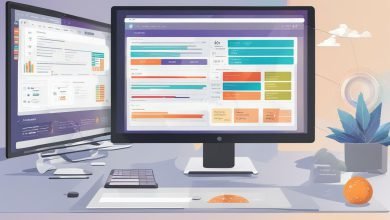
As the world continues to embrace digital transformation, cybersecurity has become an increasingly critical concern. With the rise of DevSecOps, organizations must implement effective security monitoring strategies that enable continuous security monitoring throughout the development lifecycle. In this section, we’ll explore the importance of continuous security monitoring in a DevSecOps workflow, and highlight the best practices for securing your DevSecOps environment.
Key Takeaways
- Continuous security monitoring is essential for detecting and preventing cyber attacks.
- DevSecOps security principles emphasize the importance of integrating security throughout the development lifecycle.
- Effective security monitoring strategies include automating security checks, leveraging threat intelligence, and implementing real-time monitoring solutions.
- Best practices for continuous security monitoring involve regular vulnerability scanning, logging and monitoring events, implementing incident response processes, and conducting regular security audits.
- Strengthening security in the DevSecOps workflow involves integrating security into the development process, practicing secure coding, and conducting security testing and validation.
Understanding Continuous Security Monitoring in DevSecOps
Continuous monitoring in a DevSecOps workflow is a critical aspect of ensuring the ongoing security of your development environment. By integrating security practices throughout the entire development lifecycle, you can identify vulnerabilities early on and implement measures to address them.
DevSecOps best practices involve a shift-left approach, where security is integrated from the initial stages of development. This approach allows development teams to build security into their applications and infrastructure, reducing the risk of security breaches.
Continuous monitoring in a DevSecOps workflow involves the use of automated tools and real-time monitoring solutions to detect potential security threats. By leveraging these tools, you can achieve greater visibility into your environment and proactively address security issues.
The Key Principles of Continuous Monitoring in DevSecOps
The key principles of DevSecOps security that enable continuous monitoring include:
- Integrating security into the development process
- Automating security checks
- Leveraging threat intelligence
- Implementing real-time monitoring solutions
By following these principles, you can build a strong foundation for continuous security monitoring in your DevSecOps workflow.
Implementing Effective Security Monitoring Strategies
Implementing effective security monitoring strategies is critical to maintaining the security of your DevSecOps environment. With the increasing sophistication of cyberattacks, relying on a one-time or periodic security check is no longer a viable option. Instead, organizations must adopt continuous security monitoring to identify and mitigate security threats.
One of the key strategies for continuous security monitoring is automating security checks. By automating the testing and validation of your security controls, you can reduce the risk of human error and ensure that security checks are conducted on a regular basis.
Leveraging threat intelligence is another crucial aspect of security monitoring in a DevSecOps workflow. By staying up-to-date on the latest cyber threats and vulnerabilities, you can proactively identify and mitigate potential risks.
Real-time monitoring solutions are also essential for effective security monitoring in a DevSecOps environment. By setting up real-time alerts and notifications for security events, you can quickly respond to and mitigate security incidents.
Finally, conducting regular security audits is an important component of continuous monitoring in a DevSecOps workflow. By regularly reviewing your security controls and processes, you can identify and address any weaknesses in your security posture.
By implementing these security monitoring strategies, you can enhance the security of your DevSecOps environment and reduce the risk of security breaches.
Best Practices for Continuous Security Monitoring
Continuous security monitoring is a critical component of any DevSecOps workflow. To ensure the effectiveness of your security monitoring efforts, it’s important to follow best practices. Here are some of the best practices for continuous security monitoring:
- Regular vulnerability scanning: Conduct regular vulnerability scans to identify potential security risks. This will help you stay ahead of threats and take proactive measures to prevent attacks.
- Logging and monitoring events: Keep track of all events in the DevSecOps environment by logging and monitoring. This will provide you with a comprehensive view of all activities, enabling you to detect any anomalies or suspicious behavior.
- Implementing incident response processes: Have an established incident response process in place to manage potential security breaches. This will help you respond quickly and efficiently in case of a security incident.
- Regular security audits: Conduct regular security audits to assess your DevSecOps environment’s security posture. This will help you identify any gaps or vulnerabilities and take corrective action.
By following these best practices, you can ensure the ongoing security of your DevSecOps environment and minimize the risk of security breaches.
Implementing these best practices can be challenging, but it’s essential for the security of your DevSecOps environment. By adopting these practices and integrating security throughout the entire development lifecycle, you can build a strong foundation of security and ensure the continued success of your DevSecOps workflow.
Strengthening Security in the DevSecOps Workflow
As organizations increasingly adopt DevSecOps workflows, they must ensure that security is integrated throughout the development process. In addition to implementing continuous monitoring strategies and following DevSecOps best practices, there are several key measures that can help strengthen security in the DevSecOps workflow.
Integrating Security into the Development Process
One of the most crucial steps in strengthening security in the DevSecOps workflow is to integrate security into the development process from the very beginning. This involves creating a secure coding framework that incorporates best practices for secure coding, such as input validation, secure data storage, and secure communication protocols. By embedding these practices into the development process, organizations can reduce the risk of security vulnerabilities and build more robust applications.
Following DevSecOps Best Practices
In addition to integrating security into the development process, following DevSecOps best practices is key to a secure DevSecOps workflow. This includes conducting regular security testing and validation, deploying security automation tools, leveraging containerization and microservices, and maintaining an active incident response plan. By adhering to these best practices, organizations can ensure that security is an integral part of the DevSecOps workflow.
Implementing Security Monitoring Strategies
Finally, implementing effective security monitoring strategies is essential for strengthening security in the DevSecOps workflow. This involves leveraging real-time monitoring solutions, automating security checks, and integrating threat intelligence into the monitoring process. By monitoring and analyzing security events in real-time, organizations can quickly detect and respond to security incidents, minimizing the potential impact of a breach.
In conclusion, to strengthen security in the DevSecOps workflow, organizations must integrate security into the development process, follow DevSecOps best practices, and implement effective security monitoring strategies. By adopting these measures, organizations can build a more secure DevSecOps environment and minimize the risk of security incidents.
Conclusion
In the fast-paced world of software development, security is often an afterthought. DevSecOps is an emerging approach that emphasizes the importance of integrating security into the development process. Continuous security monitoring is a critical component of DevSecOps security, enabling organizations to detect and respond to threats in real-time.
To ensure the effectiveness of your security monitoring efforts, it’s essential to implement effective security monitoring strategies. This includes automating security checks, leveraging threat intelligence, and implementing real-time monitoring solutions. By following these strategies, you can enhance the security of your DevSecOps environment.
In addition, it’s crucial to follow the best practices for continuous security monitoring. This includes regular vulnerability scanning, logging and monitoring of events, implementing incident response processes, and conducting regular security audits. By following these best practices, you can ensure the ongoing security of your DevSecOps environment.
Strategies for DevSecOps Security
To strengthen security in the DevSecOps workflow, it’s important to integrate security into the development process. This includes the adoption of secure coding practices and the use of security testing and validation. By following these strategies, you can build a robust security foundation within your DevSecOps workflow.
In conclusion, DevSecOps security is essential to ensure the ongoing security of your software development environment. By implementing effective security monitoring strategies, following best practices, and strengthening security in the DevSecOps workflow, you can enhance your cyber defense and ensure the security of your DevSecOps environment.
FAQ
Q: What is continuous security monitoring in a DevSecOps workflow?
A: Continuous security monitoring refers to the ongoing process of monitoring and assessing the security of a DevSecOps environment. It involves implementing automated security checks, real-time monitoring solutions, and leveraging threat intelligence to identify and respond to security incidents in real-time.
Q: Why is continuous security monitoring important in a DevSecOps workflow?
A: Continuous security monitoring is crucial in a DevSecOps workflow to ensure the ongoing protection of applications and systems. It helps identify and mitigate security risks, detects potential vulnerabilities, and enables quick response to security incidents, reducing the potential impact of attacks on your environment.
Q: What are some strategies for effective security monitoring in a DevSecOps workflow?
A: Some strategies for effective security monitoring in a DevSecOps workflow include automating security checks, leveraging threat intelligence tools, implementing real-time monitoring solutions, and integrating security throughout the entire development process.
Q: What are the best practices for continuous security monitoring in a DevSecOps workflow?
A: Best practices for continuous security monitoring in a DevSecOps workflow include regular vulnerability scanning, logging and monitoring events, implementing incident response processes, and conducting regular security audits to identify and address any security gaps in your environment.
Q: How can security be strengthened in the DevSecOps workflow?
A: Security in the DevSecOps workflow can be strengthened by integrating security into the development process, adopting secure coding practices, and conducting thorough security testing and validation to ensure the resilience of your applications and systems against potential threats.







